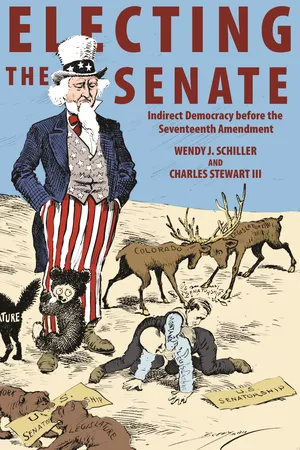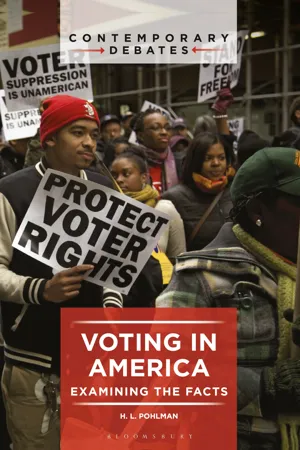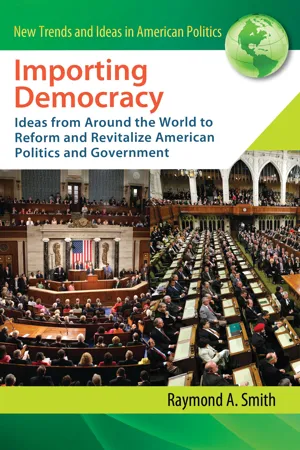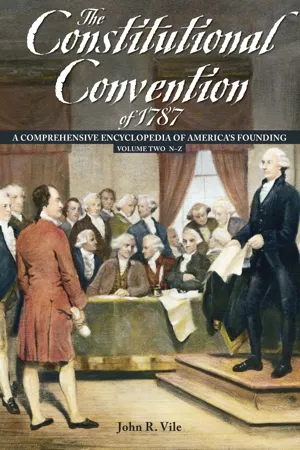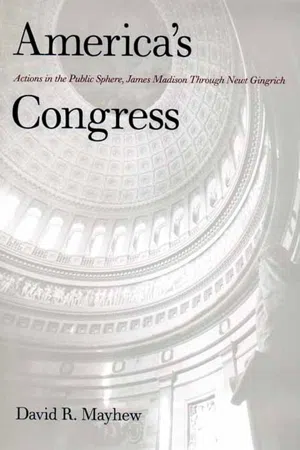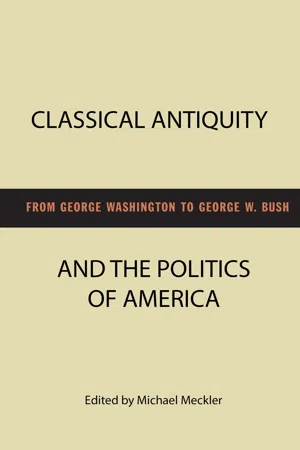Politics & International Relations
17th Amendment
The 17th Amendment to the United States Constitution, ratified in 1913, established the direct election of United States Senators by popular vote. Prior to this amendment, senators were chosen by state legislatures. The amendment aimed to reduce corruption and increase democratic representation by giving citizens a direct voice in the selection of their senators.
Written by Perlego with AI-assistance
Related key terms
1 of 5
8 Key excerpts on "17th Amendment"
- eBook - ePub
Electing the Senate
Indirect Democracy before the Seventeenth Amendment
- Wendy J. Schiller, Charles Stewart(Authors)
- 2014(Publication Date)
- Princeton University Press(Publisher)
Lawrence Lessig echoes this sentiment in arguing that the amount of money in campaigns is so overwhelmingly large, it creates an insurmountably unequal playing field in Congress between the have and have-nots. If these scholars are right, then the Seventeenth Amendment represents a type of reform in democratic governance that promised more than it delivered. 30 As we hope to make clear, there are dangers in judging the effects of the Seventeenth Amendment without a clear understanding of how elections actually were conducted before popular election took hold. Acquiring such knowledge is a major goal of this book. At the broadest level, the Seventeenth Amendment represents a change to the Constitution that was supposed to produce a more responsive and more accountable Senate than under the previous electoral system. The impetus and momentum to change the Constitution was accompanied by that very promise, and it absolutely bears on scholars of U.S. politics to dig deeper into whether that promise has been kept or broken. D ESCRIPTION OF D ATA AND R ESEARCH M ETHODS Basic facts about the unfolding of indirect Senate elections have been slow to infiltrate congressional and historical scholarship, perhaps because they occurred in the confines of state legislative chambers. Until now, scholars have primarily relied on annual editions of Appleton’s Annual Cyclopaedia and the Tribune Almanac for general summary information about Senate elections in state legislatures after the Civil War. We started with these sources, but found their usefulness limited. Appleton’s only published general information about Senate elections (e.g., who won) and ceased covering Senate elections after the 1870s. The Tribune Almanac did not begin its coverage of Senate elections until 1877 (thereby omitting 15 percent of Senate elections held during this time period) and did not list individual roll call balloting in state legislatures - eBook - ePub
- Andrew P. Napolitano(Author)
- 2012(Publication Date)
- Thomas Nelson(Publisher)
In the quest for reform, the Progressives ultimately were able to push through a constitutional amendment. However, it took a long road to get there. In 1907, Oregon was the first state effectively to craft a statute that allowed the direct election of its senators by the voters. Other states followed Oregon’s lead, and before the Seventeenth Amendment was ratified, as many as twenty-nine states had enacted similar legislation. Twenty-seven of the required thirty-one states would petition for another Constitutional Convention to amend the Constitution if Congress declined or refused to propose an amendment for the direct election of senators.The Senate had struck down every bill it was sent seeking to amend the Constitution for direct election of senators until this point. Yet faced with the incredible threats posed by opening up another Constitutional Convention, the senators finally succumbed to the populist desires. This is how the Seventeenth Amendment came to pass, through the states threatening to convince a few more to join their fight and possibly upending our entire constitutional system through another Constitutional Convention. The entire structure of the Constitution would in fact be upended, and this would be done singularly through the Seventeenth Amendment.Progressives such as Woodrow Wilson and Theodore Roosevelt had no respect for the Constitution. This amendment did not give more power to the people, as the Progressives promised, but simply took power away from the states and concentrated it in the federal government. This amendment also did nothing to eliminate corruption. Corruption in the Senate is even worse today, as C. H. Hoebeke wrote:Exorbitant expenditures, alliances with well-financed lobby groups . . . [have] continued to characterize Senate campaigns. . . . In fact, such tendencies have grown increasingly problematic. Insofar as the Senate also has participated in lavishing vast sums on federal projects of dubious value to the general welfare, and producing encyclopedic volumes of legislation that never will be read or understood by the great mass of Americans, it can hardly be the case that popular elections have strengthened the upper chamber’s resistance to the advances of special interests.12 - eBook - ePub
Voting in America
Examining the Facts
- H. L. Pohlman(Author)
- 2020(Publication Date)
- ABC-CLIO(Publisher)
https://www.everycrsreport.com/files/19830520_83-103GOV_f7c90f8fb698968e03f7ce5e3b45288dffcce08f.pdf .Paz, Isabella Grullon. “Democrats Seek Young Voters, and the Memes that Move Them.” The New York Times, April 22, 2019, available at https://www.nytimes.com/2019/04/22/us/politics/youth-voters-2020.html .Selective Service System. “Induction Statistics,” available at https://www.sss.gov/About/History-And-Records/Induction-Statistics .United States Elections Project. “Voter Turnout Demographics,” available at http://www.electproject.org/home/voter-turnout/demographics .Q8. ARE THERE ANY OTHER AMENDMENTS TO THE U.S. CONSTITUTION THAT AFFECTED THE RIGHT OF AMERICAN CITIZENS TO VOTE IN FEDERAL AND STATE ELECTIONS?Answer: Yes. The Seventeenth Amendment granted citizens the right to elect U.S. Senators; the Twenty-Second Amendment denied citizens the right to elect a president to a third term; the Twenty-Third Amendment gave citizens of Washington, DC, the right to select “electors” in presidential elections; and the Twenty-Fourth Amendment abolished poll taxes in federal elections.The Facts: The Seventeenth Amendment of the Constitution, ratified in 1913, granted citizens the right to vote for the two senators of the state in which they resided. This amendment was necessary because the original Constitution granted state legislatures the power of “chusing” U.S. senators (Article 1, Section 3). In Federalist No. 62, James Madison summarized the constitutional convention’s rationale for this method of senatorial appointment:Among the various modes which might have been devised for constituting this branch of the government, that which has been proposed by the convention is probably the most congenial with the public opinion. It is recommended by the double advantage of favoring a select appointment, and of giving to the State governments such an agency in the formation of the federal government as must secure the authority of the former, and may form a convenient link between the two systems. - eBook - PDF
Importing Democracy
Ideas from Around the World to Reform and Revitalize American Politics and Government
- Raymond A. Smith(Author)
- 2010(Publication Date)
- Praeger(Publisher)
This would strongly suggest that a constitutional conven- tion, if one is needed at all, could be used to facilitate the proposal of a range of constitutional amendments—such as those outlined throughout this book—that had already taken shape through democratic deliberation and discussion over the course of years. It may also be the case that the credible threat of a constitutional convention, with all its attendant uncertainties, could in and of itself prove to be a spur for reform. Indeed, this was the case of the 192 Importing Democracy Seventeenth Amendment, which significantly changed the character of the U.S. Senate by providing for the direct election of senators by the people of each state rather than by the respective state legislatures. This change, perhaps along with limiting presidents to two terms, was the biggest alteration to the structure of the federal government ever enacted through the amendment process. Given that large numbers of both senators and state legislatures had to assent to this change, its passage would seem to be rather implausible. But popular pressure during the Progressive Era built to such a point that, by 1913, nearly two-thirds of the states had submitted applications to call a constitu- tional convention focused on this issue, and Congress found it simpler just to propose an amendment itself than to allow a Pandora’s box to be opened. And if senators can be convinced to place their fates in the hands of the voters rather than their cronies in the state legisla- tures and if those legislatures could be persuaded to give up their power to directly influence one chamber of Congress, then many other far-reaching reforms are also eminently plausible. - eBook - PDF
The Constitutional Convention of 1787
A Comprehensive Encyclopedia of America's Founding [2 volumes]
- John R. Vile(Author)
- 2005(Publication Date)
- ABC-CLIO(Publisher)
On August 9, the delegates decided that they would allow governors temporarily to fill vacan- cies in the Senate in cases where state legislatures were not in session, but they do not otherwise ap- pear to have revisited the issue of Senate selection. Analysis Although there are some significant differences (most notably the fact that members are not qual- ified by wealth, and the positions are not heredi- tary), Elaine Swift has argued that the Senate was largely modeled on the upper house of the En- glish Parliament, known as the House of Lords (1993). Swift argues that the indirect method of selection was designed to serve as a “filtration process,” and that the six-year terms were de- signed to provide further for senatorial indepen- dence. As was true of the House of Representa- tives, Convention delegates made no explicit provision for state legislative recall or instruction of senators, and their salaries were set by Con- gress rather than by the states. Subsequent Developments In time, the Seventeenth Amendment vindicated Wilson’s proposals at the Convention and further democratized the Constitution—arguably at the expense of state powers (see Hoebeke 1995)—by providing that the people of the states would di- rectly elect members of the Senate. Legislatures in a number of states had previously specified that they would ratify the people’s choice. See Also Congress, Senate, Size; Connecticut Compromise for further reading Eidelberg, Paul. 1968. The Philosophy of the American Constitution: A Reinterpretation of the Intentions of the Founding Fathers. New York: The Free Press, 78–92. congress, senate, selection 171 Farrand, Max, ed. 1937. The Records of the Federal Con- vention. 4 vols. New Haven, CT: Yale University Press. Hoebeke, C. C. 1995. The Road to Mass Democracy: Original Intent and the Seventeenth Amendment. New Brunswick, NJ: Transaction. Swift, Elaine. 1993. - eBook - PDF
America's Congress
Actions in the Public Sphere, James Madison Through Newt Gingrich
- David R. Mayhew(Author)
- 2008(Publication Date)
It was this turn-of-the-century breed of senator that reformers of the Progressive era took aim at in promoting direct election of senators. That reform, it was thought, would break up the Senate-capped hierarchies of business-oriented influence. Earlier, we saw that the adoption of the Seventeenth Amendment in was not associated with any change in senators’ ‘‘action advantage’’ over House members (see Figure .), but Figure . shows that the reform does coincide with the plummet in organization-related actions shown for the early twentieth century. In fact, a close in-spection of the order of events around suggests that moves by the era’s reformers caused both the downfall of the senator-led party orga-nizations and the adoption of the Seventeenth Amendment, rather than that the amendment, once implemented, caused the downfall. 27 For the most part, state and local party kingpins on Capitol Hill are a story from the middle segment of American history. Since that time, leaving aside the small spike evident after , there is little to tell. In Figure ., the reading for the s and s is zero. That does not mean that MCs have stopped making new moves to stockpile and use power. In the s, for example, Senator Jesse Helms (RN.C.) devel-oped his Congressional Club as a direct-mail technique for funding right-wing candidates around the country. In the s, Congressman Tony Coelho (DCalif.) shored up the electoral position of House Democrats by . On the turn-of-the-century state organizations and their demise, see David R. Mayhew, Placing Parties in American Politics (Princeton, N.J.: Princeton University Press, ), ch. . , , shifting them toward money from business-based political action com-mittees (PACs). But action items of this contemporary kind have not in-volved state or local party organizations. - eBook - PDF
Classical Antiquity and the Politics of America
From George Washington to George W. Bush
- Michael Meckler(Author)
- 2011(Publication Date)
- Baylor University Press(Publisher)
69 The Rise of Populism, the Decline of Classical Education, and the Seventeenth Amendment The rapid economic and social changes that transformed the United States in the half century following the Civil War spawned demands for greater public participation in government and for greater government oversight of business and society. These demands united southern and western farmers angered over railroad monopolies that controlled the transportation of their produce, immigrant laborers upset over working conditions in northern factories, women who found themselves excluded from political decision making, small businessmen brought to ruin by insecure banks, and social reformers disenchanted with the poverty and despair in which many Americans lived. The solutions called for by these groups often shared an underlying concept of populism, a term that can be used to encompass ideas from both the Populist political movement of the 1890s and the Progressive movement of the 1910s. 1 Several amendments to the United States Constitution grew out of this populist fervor: the Sixteenth Amendment (ratified in 1913), which legal-ized federal income tax; the Eighteenth Amendment (ratified in 1919), which established Prohibition; the Nineteenth Amendment (ratified in 1920), which provided universal women’s suffrage; and the focus of this Michael Meckler Chapter 5 70 The Rise of Populism, the Decline of Classical Education essay, the Seventeenth Amendment (ratified in 1913), which established the direct election of United States senators. The rise in populist politics occurred as the traditional education in Greek and Latin came increasingly under criticism and marginalization. The young men of modest means who fought the Civil War and settled the West resented the social distinction classical education seemed to bestow upon their wealthier coevals from the East Coast. - eBook - PDF
The Federalist Papers
A Reader's Guide
- Kyle Scott(Author)
- 2013(Publication Date)
- Bloomsbury Academic(Publisher)
The only restriction imposed on them is, that they shall not exchange republican for anti-republican constitutions (#43: 272). Paper 42 also introduces the regulation of trade, specifically the slave trade, which Congress could not interfere with until 1808 (Article I, Section 9). But the extensive focus on a part of the Constitution that no longer applies raises the question of whether READING THE FEDERALIST PAPERS 105 the Constitution advocated by Publius is the same Constitution today, particularly in light of the structural changes made to the document with the Amendments. For instance, #45 argues that the states will retain their influence given, in part, their prominent role in electing Senators via state legislatures. Because Senators would not be directly elected, the interest of the states, and not the will of the people, would be represented in the Senate which would then serve as a check on the encroachment of the national power on state power. But this institutional check was altered in 1913 with the ratification of the 17th Amendment that provided for the direct election of Senators, thus amending Article I, Section 3 of the Constitution and perhaps altering the balance of power between the national and state governments. This is not to imply that the 17th Amendment radically altered the federal nature of our government, but the careful reader should make note of how later developments might alter Publius’ assumptions of how the government would operate and thus undermine portions of the argument. Such a critical eye should be used when reading #46 which revisits why the states will not be overrun by the national government.
Index pages curate the most relevant extracts from our library of academic textbooks. They’ve been created using an in-house natural language model (NLM), each adding context and meaning to key research topics.
